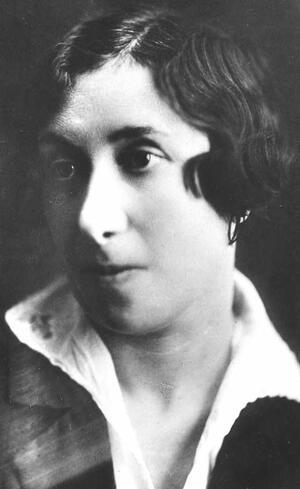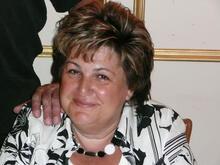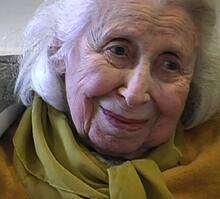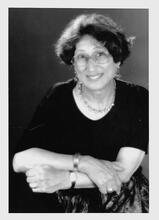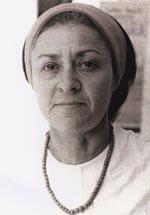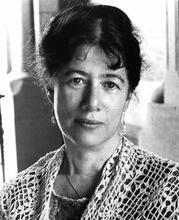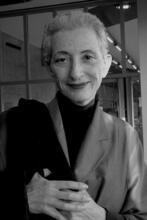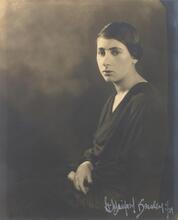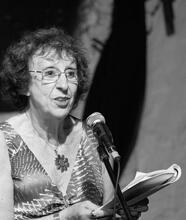Feiga Izrailevna Kogan
Growing up in a religious home in Moscow, Poet Feiga Izrailevna Kogan developed an early love for the Hebrew language. After graduating from the First Marinskii Girls’ Gymnasium in 1908, Kogan studied Hebrew literature independently while composing Moia dusha (My Soul), her first collection of poems. Although her poetry was last published in 1927, she continued writing throughout her life. Kogan also helped found the Russian Hebrew theater troupe Habimah in 1918, lectured on Russian literature at the State Institute of Dramatic Art, organized concerts, tutored in Hebrew, and worked on productions with the Central Amateur Teaching Theater. In 1964 she donated her private papers to the Russian State Archive for Literature and Art in Moscow.
Feiga Izrailevna Kogan composed books of and about Russian poetry while harboring a love of Hebrew. Although her reputation is modest, she is known among aficionados of her teacher Vyacheslav Ivanovich Ivanov (1866–1949), who, together with Aleksandr Blok (1880–1921) and Andrey Bely (1880–1934), represented the leadership troika of the second wave of Russian Symbolism. Kogan’s archives reveal that she was involved in Jewish cultural life at the beginning of the twentieth century. For instance, she wrote poems resonant with Jewish themes, and labored to bring Statements that are not Scripturally dependent and that pertain to ethics, traditions and actions of the Rabbis; the non-legal (non-halakhic) material of the Talmud.aggadah and Psalms to Russian readers through her imaginative interpretations and fastidious translations from the Hebrew. However, none of these works was published. Furthermore, she transformed her childhood interest in the Hebrew language into a vocation as she toiled, literally, behind the scenes to bring Jewish theater to life in the Russian Empire. As a founding member of Habimah, the first Hebrew theater in the world, she played an off-stage role assisting actors in correct pronunciation of their Hebrew lines.
Early Life
On August 7, 1891, Khasi Eslevna and Izrail Simonovich Kogan welcomed their daughter Feiga into the Moscow Jewish community. She joined her older sister Ita, who was four years her senior. Before his untimely death in 1903, her father was a furrier who owned a shop where he peddled fabric and fur remnants. Her mother assisted her husband with his business and managed their humble dwelling, a three-room apartment that housed two female boarders in addition to the family of four. Kogan’s childhood—which she characterized as “an enormous black hole in the heavens” (she was a sickly child frequently under the supervision of a nanny)—was considerably enhanced by words and their magical power, which enabled her to transcend her reality. As a child, even without comprehending its words, Kogan became enchanted by the sounds of the Hebrew language. Raised in an observant Jewish household, and with a father she described as the “head of the Moscow Synagogue,” Kogan received what she felt to be an inferior Jewish education. A series of rabbis’ wives tutored her and her sister in Hebrew.
Meanwhile, Kogan thrived at the local municipal grammar school and was admitted to the First Marinskii Girls’ Gymnasium. As two of the approximately twenty Jews at the gymnasium, Kogan and her sister were exempt from the usual course in religion. But they were required to prepare for an examination on Jewish history using Simon Dubnov’s text and administered by Rabbi Jacob Maze (1859–1924), the government-appointed community rabbi of Moscow.
Pursuit of Knowledge and Publishing
Upon graduation from gymnasium in 1908, Kogan embarked on an independent and daily course of study. Simultaneously, she began to compose poems that were published in 1912 in an anthology entitled Moia dusha (My Soul). Four years later, Kogan enrolled in a two-year course of study offered by the Society for Lovers of the Hebrew Language (Hovevei Sefat Ever). She struck up a friendship with a fellow classmate, Elizabeta Ivanova Zhirkova Elisheva Bichovsky (1888–1949), a non-Jew with a strong yearning to learn Hebrew, who in 1925 together with her husband Simeon Bikhowsky, immigrated to Palestine, where she began to publish Hebrew poetry under the name Elisheva. Kogan also gravitated to her teacher, Menahem Gnessin (1882–1952), who introduced his student to the pioneering efforts of Habimah. Kogan’s enthusiasm for the troupe and its goal of reviving Hebrew through drama never waned. Her glowing review of The Dybbuk appeared in the Russian newspaper Evreiskii vestnik, and over time she clipped and saved articles relating to the company’s activities. Despite her enduring interest in Habimah, her direct involvement terminated within years of its founding in 1918. As she described it, a “serious nervous disorder” forced her to leave the troupe. Like other ambitious literary women of her generation, perhaps she, too, succumbed to mental stress brought on by the unconventional trajectory of her life. Nearly thirty years old, she was unmarried and childless and would remain so throughout her life. Nevertheless, Valeri Briusov (1873–1924) invited her to be his assistant, a position she filled for at least one year, in 1919.
During her thirties, Kogan continued to enrich her education. She was a student at the State Institute of Declamation and later enrolled at the State Institute of the Word. All the while, she busied herself with writing verse, publishing a second volume of poetry Plamennik (The Torch) in 1923. Upon graduating in 1925, she became an instructor at the Institute. Throughout the remainder of her life she held a number of positions, ranging from lecturer on Russian language and literature at the State Institute of Dramatic Art to producer of literary evenings and concerts in Moscow. At the same time she tutored the children of Jewish families in Hebrew and participated in amateur productions under the auspices of the Central Amateur Teaching Theater.
Passion for Poetry
According to Kogan, however, it was poetry that remained her “eternal calling to the end.” The hundreds of unpublished poems collected in her archive attest to her words as well as to her productivity. Nearly every decade throughout her prodigious life, she would assemble her most recent compositions into a typed volume, the last dating from 1964, though her last poetry to appear in print was published in 1927. With the waning of the Symbolist movement in Russia, Kogan turned to publishing on the theory of poetry, churning out three books on the subject in the space of ten years.
At the age of seventy-three, Kogan donated the bulk of her papers to the Russian State Archive for Literature and Art in Moscow. By handing over her unpublished, self-revealing papers, she was signaling a willingness to expose the ways she had blended aspects of Russian and Jewish cultures to form her identity. She died in Moscow in 1974, at the age of eighty-three.
Selected Works by Feign Kogan
All the works were written in Russian. (Other bylines: F.K., A. Talin)
(Based on her autobibliography, RGALI, f. 2272, op. 1, d. 35)
Books:
My Soul. Moscow:1912.
(Talin, A.)Songs of a Psaltery Player. Moscow: 1917.
The Torch. Moscow: 1923.
The Art of Performing Verse. Moscow: 1935.
The Art of Reading. The Performance of Verse. Vol. 1, Moscow: 1936 and vol. 2, Moscow: 1940.
Articles, Poetry and Reviews:
Poetry in Novom zhurnale dlia vsekh. 1916.
(Talin, A.) “Songs of work and sorrow.” Rabochaia zhizn’ 10, 18 (1918).
“Ogarev.” Put’ 5 (1919).
“Hidden songs.” Khronika evreiskoi zhizni (February 28, 1919).
“In the lunar night.” Put’ 6 (1919).
“The Dybbuk.” Evreiskii vestnik 6 (1922).
Two poems in Lirika. Moscow: 1922.
“Life and learning.” In Sbornik stikhotvorenii dlia sol'noi i kollektivnoi deklamatsii. Moscow: 1923.
Article in Vestnik prosveshcheniia 5–6 (1926).
Poetry in Novye stikhi. 2 (1927).
“How to receite poetry.” Moscow: 1927 and 1934.
Article in Klubnaia stsena 1 (1928).
“Khitrev rynok.” (?) Klubnaia stsena 6 (1928).
Poetry translations in Krasnaia niva (January 13, 1929).
“Proletariat—building a new life.” Derevenskii samouchka 1 (1929).
Material on the life and work of Gorkii. Moscow: 1930 and 1940.
“Reading circle of artistic literature.” Klub 3 (1934).
“How to recite poetry.” Kolkhoznyi aktivist 12 (November 1934): 35–39.
“Learn from the classics. Work on your writing.” Kolkoznyi aktivist 1 (January 1935): 31–33.
“What is the art of literary declamation and what is its importance.” Kolkoznyi aktivist 3–4 (February 1935): 76–78.
“Master of literary genres.” Moskovskii bol’shevik (February 4, 1942).
“How to read Maiakovsky’s poetry.” Literatura v shkole 5–6 (1946).
Two articles on art in Kul’turno-prosvetitel’naia rabota 1–2 (1949).
Further Information on Kogan:
Balin, Carole. “A Jewish Life Behind the Scenes: Feiga Izrailevna Kogan (1891–1974).&rdquo.
In To Reveal Our Hearts: Jewish Women Writers in Tsarist Russia, 124–155. New York: 2000.
Her papers are at RGALI (Russian State Archive of Literature and Art), Moscow, fond 2272, opis 1 and 2 (1908–1968).
Ledkovsky, Marina. Charlotte Rosenthal and Mary Zirin, eds. “Feiga Kogan.” In Dictionary of Russian Women Writers. Westport, CT: 1994.
Rischin, Ruth. “F.I. Kogan (1891–1974): Translation of the Psalms,” in Jews and Slavs 2 (1994): 193–222.

